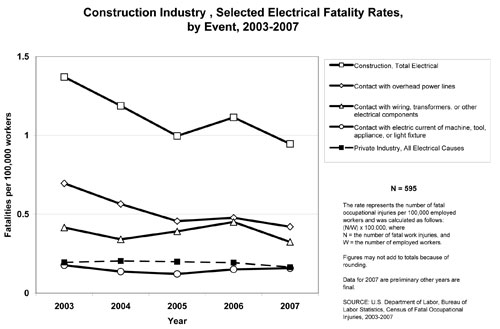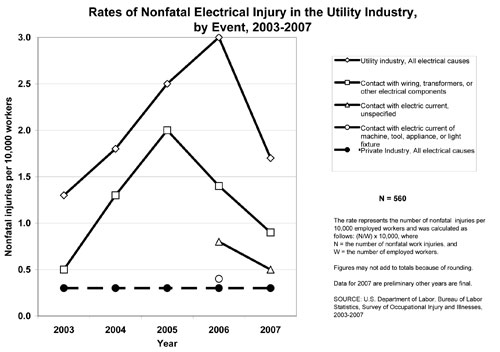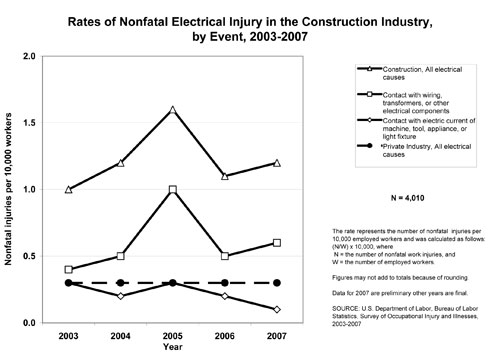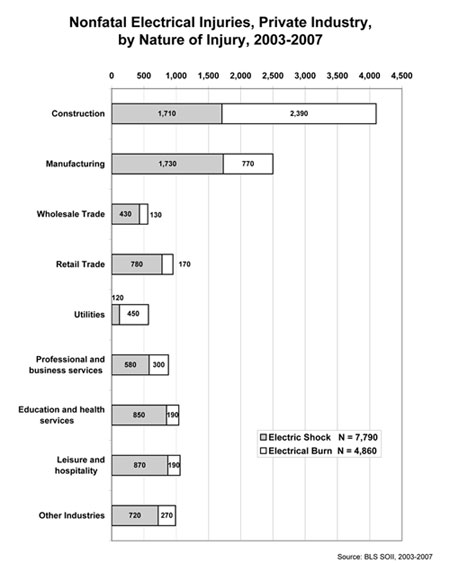Next year we will commemorate the fortieth anniversary of the U.S. Department of Labor Occupational Safety and Health Administration (OSHA). Since its creation, overall workplace fatalities have been cut by more than 60 percent and occupational injury and illness rates have declined by 40 percent. All of this occurred during an era of unprecedented growth in the United States where the total number of workers more than doubled in size; however, thousands of work-related fatalities and life altering injuries still occur each year in spite of these dramatic advancements in health and safety. As we focus on National Electrical Safety Month this May, it is important that we pause for a moment not only recognize how far we have come in saving lives through safer work practices and enhanced equipment, but also to remember there is still much we can do to prevent workplace tragedies.
This past year, the Electrical Safety Foundation International (ESFI) began an extensive review of existing research on electrical injuries and fatalities. At the conclusion of this review, the foundation determined that more information needed to be made available to the industry so that important trends could be detected and responded to in as timely a manner as possible. Through this process, we were reintroduced to a study that had examined electrical injuries and fatalities using data from 1992–2002 that had been collected by the Bureau of Labor Statistics. Working closely with Jim Cawley, a National Institute of Occupational Safety & Health (NIOSH) researcher and one of the original authors of that study, ESFI compiled industry-specific data reflecting the events that have transpired in fatal and nonfatal electrical injuries since that time. As part of this new initiative, ESFI examined documented occupational electrical injuries that occurred in the United States between 2003 and 2007. An analysis of this data revealed injury trends within select industries, revealed statistics about common work-related injuries, and allowed for calculation of both fatal and nonfatal electrical injury rates. In addition, the nonfatal electrical shock and burn injury experience of select industries were also examined.
Though the results of our assessment were in many ways encouraging, they also revealed critical signs of warning that merit the attention of stakeholders across all industry sectors. The good news is that by focusing on the industry-wide trends in electrically-related fatalities and injuries we are able to confirm that efforts to create a culture of safety are in fact beginning to have an impact. The numbers alone indicate that we are experiencing substantially fewer deaths and injuries than we were fifteen years ago. In 1994, which serves as the fifteen-year high watermark, there were 348 electrically-related fatalities and 6,018 injuries; in contrast, in 2007 there were a total of 212 electrically-related fatalities and 2,540 injuries reported. This decrease is eye-opening and it becomes even more dramatic when we consider the human context. At a minimum, this data offers a sound reminder that development and adherence to safety standards and programs can and does make a significant difference. However, it is also important to note that in spite of this overall decline, fatality rates in certain industries have remained static — or have even risen — over the last five years.
Accident data source
In order to determine the number of electrically-related fatalities and injuries that occur each year in the United States, ESFI utilized information from the U.S. Bureau of Labor Statistics (BLS). For fatal accidents BLS performs an actual count of workplace deaths and verifies the cause of each fatality using death certificates, newspaper articles, and police reports. Fatal accident statistics include all workers over 16 years of age. Counting the number of nonfatal accidents becomes somewhat more complicated, and BLS statistically estimates the number of these accidents using a survey of approximately 230,000 employers each year.1
Electrical accident summary
From 2003 to 2007, ESFI found that 28,401 workers died on the job. The most common accident types were transportation accidents (10,363 cases), followed by assaults and violent acts (4,130), and falls (3,950). In contrast, worker contact with electric current in some shape or form was responsible for 1,213 fatal workplace accidents during this period. Additionally, 13,150 workers were so severely injured from these electrical contacts that their injuries required time off from work.
Not surprising, contact with overhead power lines was by far the leading category of on-the-job electrical death. In fact, 43 percent of all occupational electrical fatalities during this five-year period can be attributed to contact with overhead power lines. However, worker contact with overhead power lines was involved in only two percent of nonfatal electrical accidents. This finding only emphasizes the important need to train employees to be aware of power lines in their work vicinity as accidents involving these lines are far more likely to kill rather than injure the worker.
The second leading category of electrical fatality involves workers coming in contact with wiring, transformers, or other electrical components. This is the type of accident that occurs more often to an employee whose job routinely involves working with electrical components such as an electrician or contractor. This category accounted for 28 percent of electrical fatalities and 37 percent of nonfatal electrical accidents.
The third leading category of electrical fatalities involved workers coming into contact with electric current from machines, tools, appliances, or light fixtures. This type of accident occurs more often to workers whose job duties included mechanical and electrical maintenance. Accidental electrocution due to contact with tools and apparatus whose grounding conductors were faulty or missing would be included in this category. This type of accident accounted for 18 percent of all electrical fatalities and 35 percent of nonfatal electrical accidents.
One widely held misconception involves the number of electrical fatalities due to worker contact with underground, buried power lines. Our examination of the data, found only five such fatalities over the five-year period from 2003–2007. In contrast, 45 workers were struck and killed by lightning during that time. An additional 27 workers died in electrical accidents whose exact circumstances could not be identified.
Electrical injury rates
Examining electrical injury rates also provided some interesting insights. Computing a rate of injury is helpful becase it normalizes the data with respect to employment and allows for comparison of electrical injury experiences between industries of different sizes. The utility industry had the highest rate of electrical fatalities in 2004 (1.6 fatalities per 100,000 workers), 2006 (1.8), and 2007 (1.4). (See figure 1.)2 There were approximately 560,000 workers employed in all sectors (electric, gas, water, and sewer) of the utility industry in 2007. Not surprising, most of the electrical injuries in the sector occurred in the electrical utility industry. Fifty-nine utility workers died in electrical accidents between 2003 and 2007. Nonfatal electrical injury rates in the utility industry rose steadily from 2003 (1.3 per 10,000 workers) to a peak in 2006 (3.0) and returned to 1.7 in 2007. (See figure 3.) The rise in injury rates in the utility industry was driven mainly by an increased number of electrical burns (this category includes all types of electrical burns, including arc flash burns, conduction burns, etc.). The utility industry reported 120 nonfatal injuries from electric shock and 450 from electrical burns.
In 2007, the construction industry was comprised of approximately 9.5 million workers. Historically, this industry has also had the greatest number of electrical fatalities. This trend continued for 2003–2007, with 52 percent of occupational electrical fatalities occurring in construction. Electricians sustained 47 percent of the electrical fatalities in construction followed by construction laborers (23 percent), and painters, roofers, and carpenters with 6 percent in each occupation. Over the last five years, construction industry rates have shown steady improvement from a high in 2003 (1.4) to its 2007 rate of 0.9 fatalities per 100,000 workers. (See figure 2.) However, it is important to remember that across that same period, the rate of electrical fatalities for all of private industry remained constant at 0.2. In the construction industry the rate of nonfatal electrical injury rose from 2003 (1.0) to 2005 (1.6) and declined in 2006 (1.1). (See figure 4.) The electrical burn injury rate in the construction industry hovered between 0.5 and 1.0 from 2003 through 2007. Construction was one of only two industries (the other being the utility industry) in which the number of nonfatal electrical burn injuries exceeded the number of electrical shock injuries. (See figure 5.) There were 2,390 electrical burn injuries in construction and 1,710 electrical shock injuries.

Figure 1.

Figure 2

Figure 3

Figure 4

Figure 5
Overall, the results of this study were very promising. Compared to fifteen years ago, more lives are being saved and far fewer individuals are forced to cope with the life-altering trauma that can accompany an electrical injury. However, as an industry we can and must do better. In 2007, more than 2,700 workers and their families were tremendously impacted because of electrical accidents on the job. We strongly believe that zero is the only acceptable number of fatalities and injuries in the workplace. To this end, ESFI launched the Never Assume Electrical Safety Series which is the foundation’s newest and most advanced resource in addressing workplace safety. Developed by a panel of safety experts, the Never Assume Electrical Safety Series is a collection of comprehensive video modules and related materials geared towards electrically qualified individuals working in industrial and construction environments. It is just the beginning to new steps the foundation will make to help bring our goal of zero electrical fatalities to fruition. As we commemorate National Electrical Safety Month, we hope that you will reexamine your workplace and take the steps necessary to make 2009 the most electrically-safe year we have ever had.
To learn more about ESFI and electrical safety, visit www.electrical-safety.org, or contact us directly by email atinfo@esfi.orgor by phone at (703) 841-3291.
1 Estimates of nonfatal injuries exclude certain groups, for example, farm workers on farms employing fewer than 11 workers and the self-employed. For detailed information on the data, go to the BLS website athttp://www.bls.gov/iif/#data.
2 Rates of fatal injury are reported per 100,000 workers and nonfatal injuries are reported per 10,000 workers.

![Figure 1 – [Twist-on connectors specifically designed for copper-clad aluminum splicing. Image Credit: IDEAL Electrical]](https://iaeimagazine.org/wp-content/uploads/2025/08/Fig1_CCATwister.png)









Find Us on Socials